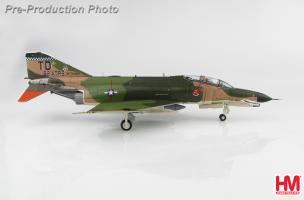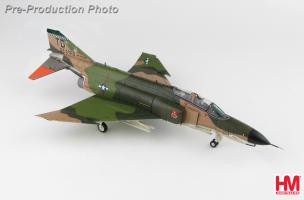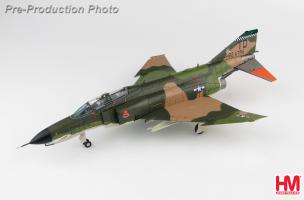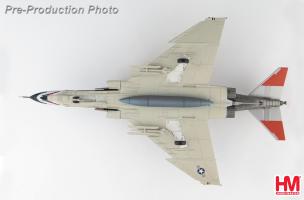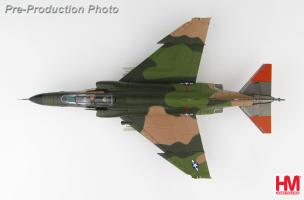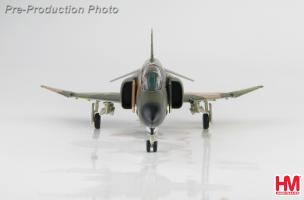Hobby Master Archive
Air Power Jets 1/72
F-4
McDonnell Douglas QF-4E Phantom II 53rd WEG, 82 ATRS, 2016 USAF Farewell
Hobby Master 1/72 Air Power Series HA19012 McDonnell Douglas QF-4E Phantom II 53rd WEG, 82 ATRS, 2016 USAF Farewell
True 1/72 scale. Professionally painted. Great attention to detail. All markings are Tampoed (pad applied). Option to display the model on a stand that is provided. Model can be shown with the landing gear in the down or up positions. Loads of optional armament provided. Canopy can be displayed open or closed. Pilot figures included. Extremely heavy metal with a minimum of plastic. Highly collectable.
The F-4E variant was an improved version of the C/D with an elongated nose and compact radar. These two things made it possible to install a 20mm M61A1 6 barrel 640 round Vulcan gun pod in the nose. The F-4E was the most produced variant with 1387 aircraft being made over its 12 year production period. The “E” also equipped more air forces than any other variant of the Phantom II.
On December 21, 2016 the USAF officially ended the use of the McDonnell Douglas QF-4E Phantom II when it was used to make a final fly-pass at Holloman AFB. The QF-4E had replaced the QF-106 that had previously been used by the 53rd WEG (Weapons Evaluation Group) / 82nd ATRS (Aerial Targets Squadron). The F-4 has been in service with the U.S. military since 1963 and was the primary multi-role aircraft through the 190s and 70s. The QF-4 provides a realistic full-scale target for air-to-air weapons system evaluation, development and testing.
Specifications for the F-4E Phantom II / F-4EJ They are virtually identical except for the restricted equipment: This included removal of the in-flight refueling receptacle that was later retrofitted, no leading edge slats, ground attack control equipment such as weapons and bomb delivery systems and the addition of modern electronic equipment including a data link system and radar warning receiver. Most or all this equipment was eventually reinstalled.
Number Built: F-4E - 5,195 / F-4EJ - 154 with 138 built in Japan under license.
Interesting trivia: Each aircraft has 54,197 feet of wiring and 643,000 fasteners holding it together.
Engines: 2 X General Electric J79-GE-17 turbojets, 11,870 lb.s.t dry, 17,900 lb.s.t. with afterburner.
Performance: Maximum speed - 1430 mph at 36,000 feet (Mach 2.21), 914 mph at sea level (Mach 1.19). Cruising speed - 585 mph. Landing speed - 158 mph. Initial climb rate - 61,400 feet per minute. Service ceiling - 62,250 feet. Combat ceiling - 59,600 feet. Combat range - 595 miles. Normal range - 1,100 miles. Maximum range - 1,885 miles with maximum external fuel.
Weights: Empty - 29,535 pounds. Gross - 40,562 pounds. Combat weight - 38,019 pounds. Maximum takeoff weight - 61,651 pounds.
Dimensions: Wingspan - 38 feet 5 inches. Wing area - 530 square feet. Length - 63 feet 0 inches. Height - 16 feet 6 inches.
Fuel: Maximum internal fuel in the fuselage tanks - 1364 US gallons (up to block 40) or 1225 US gallons (block 41 and beyond). An additional 630 gallons of fuel could be carried in internal tanks inside the wings. Maximum external fuel - 600 US gallons in a centerline tank carried underneath the fuselage. Plus 370 US gallons in each of two tanks carried underneath the outer wing pylons. Total fuel load - 3,334 US gallons (up to block 40) or 3,195 US gallons (block 41 and beyond).
Armament: 1 X 20-mm M61A1 cannon with 639 rounds. 4 X AIM-7 Sparrow semi-active radar homing air-to-air missiles in semi- recessed slots in the fuselage belly. 2 to 4 X AIM-9 Sidewinder infra-red homing air-to-air missiles carried under the wings on the inboard pylons. A total offensive load of up to 16,000 pounds could be carried on the centerline and four under-wing hard-points.
| Added to archive | 2020-01-25 |
| Last modified | 2020-01-25 |
| Leaflet | 2019-09-01 September 2019 |
